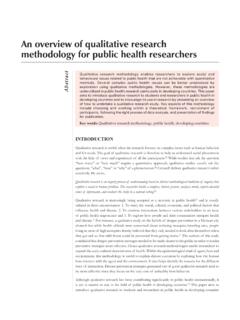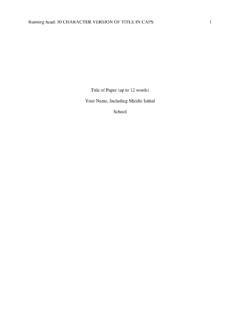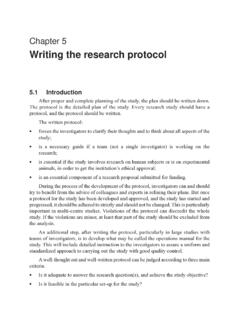Transcription of How to Write a Health Policy Brief
1 How to Write a Health Policy BriefShale L. Wong, MD, MSPH,and Larry A. Green, MDUniversity of Colorado School of MedicineAndrew W. Bazemore, MD, MPHR obert Graham Policy Center, Washington, DCBenjamin F. Miller, PsyDUniversity of Colorado School of MedicineAlthough many Health care professionals are interested in Health Policy , relatively fewhave training in how to utilize their clinical experience and scientific knowledge toimpact Policy . Developing a Policy Brief is one approach that Health professionals mayuse to draw attention to important evidence that relates to Policy . This article offersguidance on how to Write a Policy Brief by outlining 4 steps: (a) define the problem, (b)state the Policy , (c) make your case, and (d) discuss the impact.
2 The steps and tips offera starting point for Health care professionals interested in Health Policy and translatingresearch or clinical experience to impact : Health Policy , Policy Brief , healthcareIn today s practice of medicine, clinicians,researchers and Health professionals are fre-quently interested in Health Policy and seekopportunities to weigh in on issues where theymay be both well-informed and well-positionedto take action. However, traditional training ofhealth professionals does not prepare us to con-sider or discuss our work for the purpose ofimpacting Policy . Understanding some basicguidance for translating unique clinical experi-ence or scientific knowledge into Policy terms,is the first step toward developing a Policy well-written Policy Brief has a clear and spe-cific purpose and assumes the author s under-standing of what it is, and what it is not, as wellas clearly targeting the audience for whom it isintended.
3 Writing a Brief , while conceptuallystraightforward, may be challenging to initiateor compose. We offer an approach to preparinga Policy Brief , aiming to provide a point ofdeparture for individuals in the Health profes-sions who seek a starting Policy may broadly be consideredmovementin a direction for a reason, a Policy Brief would inturn be afocused discussion of an action toachieve intentional and purposeful discussion should include the best availabledata or evidence to support a devised Policy orrange of Policy options, and a narrative analysisthat considers the impact of a proposed Policy . Asimportant as it is to know what constitutes a policybrief, it is important to recognize what a policybrief is not. A Policy Brief is not equivalent to anadvocacy statement and while it may inform ormotivate action, it should refrainfrom advocatinga singular call to action.
4 Nor is it an opinionpiece that could suggest implications beyondparameters defined by the supportive Policy Brief is analytic in nature and allowsthe author to remain objective even if the evi-dence appears persuasive. Furthermore, a briefis by definition, Brief , which often presents thegreatest challenge to an author who must sharethe specific purpose while limiting the compre-This article was published Online First December 1, L. Wong, MD, MSPH, Department of Pediatric,Eugene S. Farley, Jr. Health Policy Center, University ofColorado School of Medicine; Larry A. Green, MD, De-partment of Family Medicine, Eugene S. Farley, Jr. HealthPolicy Center, University of Colorado School of Medicine;Andrew W. Bazemore, MD, MPH, Robert Graham PolicyCenter, Washington, DC; Benjamin F.
5 Miller, PsyD, De-partment of Family Medicine, Eugene S. Farley, Jr. HealthPolicy Center, University of Colorado School of concerning this article should be ad-dressed to Benjamin F. Miller, PsyD, Department of FamilyMedicine, Eugene S. Farley, Jr. Health Policy Center, Uni-versity of Colorado School of Medicine, 12631 East 17thAvenue, Aurora, CO 80045. E-mail: Systems, & Health 2016 American Psychological Association2017, Vol. 35, No. 1, 21 241091-7527/17/$ context, rationale and potential variabil-ity in implementation, regulation or applicationof a proposed first step is to call it what it is, a policybrief. Include those words in the title to framethe issue that follows. A variety of other kindsof documents may make mention of Policy butclearly have a different focus.
6 Issue and re-search briefs may present data and evidence toarticulate a problem without necessarily sug-gesting Policy as a solution. In contrast, a policybrief puts front and center the problem to beaddressed by Policy , then presents relevant ev-idence to support or analyze a proposed , for example, the introduction of thispolicy Brief by Richardson, recently publishedin Health Affairs. It begins with a heading ofHealth Policy Brief followed by the title, Off-Label Drug Promotion. In the first paragraph weread,.. the FDA generally does not restrict physicianprescribing practices, and many drugs are prescribed off label that is, for indications that have not beenapproved by the agency. In recent years there has beenrenewed debate over whether and how the FDA shouldregulate the pharmaceutical industry s communicationto physicians around off-label uses.
7 (Richardson, 2016)This early statement very clearly frames thediscussion to follow, regarding potential policyregulation that would have direct impact onclinical is no ideal length for a Policy state-ment. The framework that we propose is in-tended for a focused Policy Brief , 1 4 pages. A one-pager may present talking points with asingle figure to illustrate key data. Use of im-ages and infographics, or inclusion of a storymay extend the length but also prove influentialto illustrate the data. A more complete explora-tion of an issue that describes a variety of policyoptions could best be represented in a whitepaper of 8, 20, or 50 pages. Different styles andlengths depend on the purpose, the complexityof the issue, and perhaps most importantly, theaudience of interest.
8 When we seek the attentionof policymakers, the most relevant data andframing will take into consideration direct im-pact on their constituency. A Policy action thatimpacts a specific interest group will be narrowin scope, focusing to reduce extraneous both narrow and broad audiences under-standing the political context and environmentis essential. This allows opportunity to bringforward opposing views and potential barriersin the form of counter arguments to proposedpolicy actions. Table 1 provides examples toillustrate differences in style and length for pol-icy, research and issue this report, we recognize that our audi-ence of interest is largely heath care providers,clinicians, clinical researchers, or those healthprofessionals who are seeking a way to framepolicy-relevant data in a Brief that persuadesdeeper review or understanding of a Health orhealth care issue.
9 This should be considered aform of Health communication that will in turn,target another audience that has power or inter-est to influence Policy -making. Thus, we offer asimple framework to guide your developmentof a Policy Brief : 4 steps and 4 tips to get StepsStep 1: Define the ProblemWhat is the issue or the problem? Why is itimportant? Why now? Who is impacted andwho cares? When defining your problem, bespecific to your audience and clearly frame theissue. Who has the influence to make a changethat will address this problem? If the audience isexpected to be policymakers (and their staff),community leaders (grassroots or grasstops), in-dustry or nongovernmental organization execu-tives, the problem should be defined in termsrelevant to their Policy intervention, 2: State the PolicyIdentify 1 3 specific Policy actions that willaddress the problem.
10 In a focused Policy Brief ,the goal is to limit the menu of potential actionsto target a Policy approach of interest. A moreextensive Policy review or proposal may be acomprehensive white paper that elucidatesmany related Policy options. Consider a focusedbrief to describe one Policy in depth as opposedto exploring a problem and all of the potentialpolicy 3: Make Your CaseDisplay and describe relevant data using 1 2figures or tables; declare potential bias based onthe data sources; refer to other related policies22 WONG, GREEN, BAZEMORE, AND MILLER that are not discussed. Redirect to other policyreferences when possible or 4: Discuss the ImpactBriefly discuss the implications of both actionand inaction; analyze estimated pros and cons ofthe Policy action; consider intended and unin-tended consequences; address opposing argu-ments.















